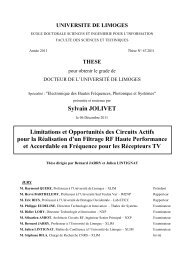Contribution à la conception optimale en terme de linéarité et ...
Contribution à la conception optimale en terme de linéarité et ...
Contribution à la conception optimale en terme de linéarité et ...
You also want an ePaper? Increase the reach of your titles
YUMPU automatically turns print PDFs into web optimized ePapers that Google loves.
CHAPITRE II – CONSIDERATIONS GENERALES SUR LA LINEARITE DES AMPLIFICATEURS DE PUISSANCE<br />
II.5.2.5.2. - Modèle avec mémoire<br />
Comme nous l’avons vu précé<strong>de</strong>mm<strong>en</strong>t dans un système <strong>à</strong> mémoire, le gain complexe<br />
( λ ) peut s’avérer insuffisant. Il faut considérer <strong>à</strong> sa p<strong>la</strong>ce une fonction <strong>de</strong> <strong>de</strong>scription ( f )<br />
ou <strong>de</strong> manière équival<strong>en</strong>te, une réponse impulsionnelle <strong>de</strong> <strong>de</strong>scription t . La fonction <strong>de</strong><br />
<strong>de</strong>scription dép<strong>en</strong>d <strong>de</strong> <strong>la</strong> puissance <strong>et</strong> <strong>de</strong>s propriétés statistiques du signal x t .<br />
L’équation (10) <strong>de</strong>vi<strong>en</strong>t alors :<br />
( t)<br />
h ( t)<br />
* x(<br />
t)<br />
n(<br />
t)<br />
A partir <strong>de</strong> l’équation (9) nous pouvons écrire :<br />
d’où<br />
réalisation.<br />
E<br />
E<br />
h x<br />
()<br />
()<br />
H x<br />
y = x +<br />
(13)<br />
( t)<br />
y(<br />
t)<br />
− h ( t)<br />
* x(<br />
t)<br />
n x<br />
= (14)<br />
( ) x(<br />
+ τ)<br />
)<br />
*<br />
* * *<br />
( n () t x(<br />
t τ)<br />
) = E y () t − h () t * x () t<br />
*<br />
*<br />
( n () t x(<br />
t τ)<br />
) = E y () t<br />
h x<br />
( t)<br />
+ t<br />
x<br />
* *<br />
( x(<br />
t + τ)<br />
) − E(<br />
h ( u)<br />
. x t − u)<br />
du.<br />
x(<br />
t + τ)<br />
+ ∫ +∞<br />
−∞<br />
x<br />
( t)<br />
( )<br />
La fonction dép<strong>en</strong>d <strong>de</strong> <strong>la</strong> statistique <strong>de</strong> x mais elle est indép<strong>en</strong>dante <strong>de</strong> <strong>la</strong><br />
E<br />
*<br />
*<br />
( n () t x(<br />
t τ)<br />
) = E y () t<br />
avec <strong>la</strong> stationnarité nous avons<br />
E<br />
En posant v = u + τ<br />
* *<br />
( x(<br />
t + τ)<br />
) − h ( u)<br />
. E x ( t − u)<br />
x(<br />
t + τ)<br />
+ ∫ +∞<br />
−∞<br />
*<br />
*<br />
( n () t x(<br />
t τ)<br />
) = E y () t<br />
x<br />
( )du<br />
* *<br />
( x(<br />
t + τ)<br />
) − h ( u)<br />
. E x ( t)<br />
x(<br />
t + τ + u)<br />
+ ∫ +∞<br />
−∞<br />
*<br />
*<br />
( n () t x(<br />
t τ)<br />
) = E y () t<br />
x<br />
( )du<br />
*<br />
( x(<br />
t + τ)<br />
) − h ( u)<br />
. E ( u + τ)du<br />
E + ∫ x xx<br />
+∞<br />
−∞<br />
*<br />
*<br />
( n () t x(<br />
t + τ)<br />
) = E y () t<br />
*<br />
( x(<br />
t + τ)<br />
) − h ( v − τ)<br />
. E ( v)dv<br />
E ∫ x xx<br />
+∞<br />
−∞<br />
E<br />
*<br />
*<br />
( n () t x(<br />
t τ)<br />
) = E y () t<br />
*<br />
( x(<br />
t + τ)<br />
) − h ( − τ)<br />
* E (τ<br />
+ xx<br />
78<br />
)
















